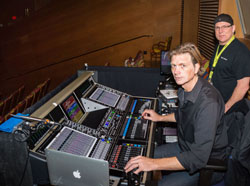
The Music Center in downtown Los Angeles has upgraded its front of house and monitor mixing consoles at Walt Disney Concert Hall to fiber-networked DiGiCo digital consoles as the complex celebrates its 50th anniversary.
ATK AudioTek of Valencia, CA supplied and installed an SD5 at front of house SD10 at the monitor position, and shared SD Rack at the 2,252-seat Walt Disney Concert Hall, one of four venues that comprise The Music Center campus, which first opened in 1964.
“With our success at the Hollywood Bowl using DiGiCo, we considered the consoles pretty seriously when it was time to look at what we could do for the Concert Hall,” explains Fred Vogler, principal sound designer and mixer for LA Philharmonic. “We wanted a desk that was easy to use, had good input/output flexibility, and provided future expandability. It also made sense for us to have the same type of consoles at the summer home of the LA Phil when we’re at the Concert Hall during the winter season.”
The 96 kHz operation of the DiGiCo consoles at the Hollywood Bowl played a significant part in the audio quality improvements at that venue, according to Kevin Wapner, the hall’s head of audio/video, and assistant audio/video and monitor mixer at the bowl. “So the year before we made this latest purchase decision, we converted all our paths at the Concert Hall to 96k capability via Rocknet in preparation for moving in this direction,” he says. “The transition was really smooth, going from the previous consoles to the DiGiCos and using the fiber loop between them. AudioTek’s integration and their knowledge got us up and going—it was seamless.”
No less important are the matrix output capabilities of the SD5. While the clarity of the acoustics in the Concert Hall, designed by acoustician Yasuhisa Toyota, rarely requires the DiGiCo front of house console to handle more than 40 inputs for non-orchestral performances, the SD5 enables granular control of the complex sound reinforcement system, which is deployed only when needed. Custom left and right main speakers on the stage fire forward, sideways, and rearward, as do the center-hung arrays. Front fills cover the first few rows of seating, and there are also ceiling speakers and balcony delays.
“Everything is addressable,” Vogler adds. “You can change the level to the forward JBL VT4887 array—the upper and lower portions are separately addressed—as well as the sides and rear. You can also individually address the main custom ATC speakers. That was another factor in picking the DiGiCo console—we needed something with excellent matrixing and routing. The EQ sounds great on this board and the routing is superb. It’s a good tool for defining the sound and sending it where you want it to go. And the way you can arrange things on the console is very intuitive and comfortable.”
The resident Concert Hall engineers, Randy Piotroski (front of house) and Leland Alexander (monitors), make extensive use of the DiGiCo system’s snapshot capabilities, according to Wapner: “We have starting templates, because the distribution of the PA is so complex, and we don’t want to reinvent it for each show.” Snapshot templates have been defined for the Concert Hall’s Symphonies for Schools schedule; Casual Fridays, which includes a Q&A session between the artists and the audience; jazz and other amplified ensembles; choral and opera performances; and other events.
During LA Phil performances, which make full use of the hall’s natural acoustics, the SD5 is moved on its custom stand, built in-house, to a booth behind the mix position for use as a recording console. “Archival recording is by and large a stereo mix onto a flash drive,” reports Wapner. “It’s usually five mics across the front—left, right, and the tree—and the audience mics.” For broadcast recordings, a Merging Technologies Pyramix system tracks every microphone via Horus converters.
Equipment purchase decisions at the Walt Disney Concert Hall undergo very careful consideration, Wapner notes. “It’s really high quality audio here, and there’s a lot of critical listening. We always say it’s like being under a microscope, times a thousand.”
“Whatever piece of technology you introduce into this environment is going to be scrutinized. The expectations of the management and the artists are extremely high, so sonic performance as well as how it looks and operates are a really big deal,” adds Vogler. “We really enjoy the sound, the performance and the ease of use. Everybody who works on the board comes away feeling like they had an easy time on it.”
